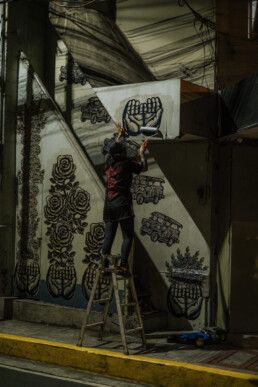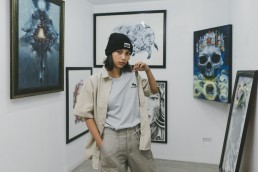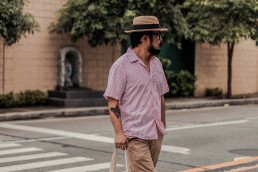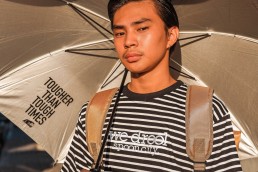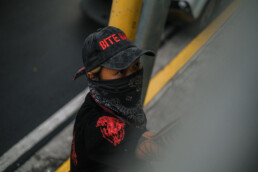
Art with no borders and creation taken from the scheme of capital are just some of the many inspirations from which Kill Joy derives her thoughtful, intentional, and often politically-charged artistic commentary.
A printmaker and wood carver by profession, her work heavily honors the Mexican art of relief carving and infuses it with Filipino artist-activist’s perspective with room to spare. Taking from the craft using strong, dramatic, yet readable visuals, the art of printmaking and relief carving has served a reliable and consistent toolbox for the activist-artist since her formative days, taking the ethos of ultra-thick lines and pronounced, maximized aesthetics for progressive messages that demand gravitás — land, wage, the effect of and on native diasporas, and the tight-knit relationship between freedom and creativity have.
We got to speak with her regarding such issues, how these ideas proliferated in the sense of the Philippine-American experience and her many readings and takeaways from the various cultures and other diasporic communities that she has encountered and immersed herself in all those years of growth and study.
How did you come up with Kill Joy? What’s the symbolism of that with what you do?
“Kill Joy” was a phrase I heard frequently while growing up, both in the Philippines and among Filipinos in Texas. Aside from already being related to my given name, Joy, I questioned why I was drawn to it, up until I met a shaman who suggested that I change my name, which led me to a personal crisis. I questioned if I had chosen unwisely and if I was manifesting bad energy with the connotation of “kill.” For a brief time, I switched up my name to remove myself (Joy) from it.
What helped me own up to that name was that it is a common phrase (“kill-joy”) and that gives a sense of shared ownership. I like that idea. It is a name that I, and many people, identify with. “Kill Joy” doesn’t belong to me, rather it’s something I share with friends and strangers around the world.
I approached the phrase and idea of ‘Kill Joy’ as the reminder that it provides: the present version of myself is constantly dying to give birth to me in the future. It emphasizes the idea of dying in the present to be reborn in the future, which is a perspective that helps me throughout life. Killing “Joy” by self, the named ego, and being reborn continuously; something ends, and something new begins.

How do you factor in your Texan connections in relation to your artistic journey? And how does your experience with the Mexican community as well as your Filipino heritage influence your artmaking?
I could say that it first started in West Texas, which despite its reputation for cowboys, bandits, and the Westerns, is often overlooked compared to the major cities in East Texas like Dallas or Houston. West Texas is filled with oil fields and the smell of petroleum, and was kind of a cultural void; this lack of aesthetics helped foster the maximalist style in my art.
First, I started from Oregon as project manager for an arts company. Eventually, I lived in Mexico City some years after college, a time when I was seriously becoming engaged in my art practice: printmaking, and mural painting. Mexico City is a cultural capital filled with inspiration, and I was immersed in a vibrant artistic environment. Moving to Mexico when I was 25 and staying there until I was 30, during a period of my life when I began focusing on myself as a full-time artist, helped me realize the connections between the two places: a sense of ‘noble lawlessness.’

“I have a deep love for the Philippines and its culture, I also recognize that my identity is not solely Filipino.. It’s the responsibility of Fil-Ams to be understanding of our own experiences and also of the living conditions of the Filipino people, unique from that of Filipino people living in the West.”
I started thinking more about my ancestral lands, the Philippines, a place I feel deeply connected to, which also exhibits this noble lawlessness. I’ve recently had the privilege of meeting incredible people on the front lines of social and environmental issues in the Philippines. Like Mexico, the energy is powerful and unrelenting.
There is a strong desire among the Filipino diaspora to reconnect with the Philippines because of the ocean-wide disconnect imposed on our disparate communities. I have a deep love for the Philippines and its culture, I also recognize that my identity is not solely Filipino. I might not understand the cultural context, jokes, or pop references, and I’m aware that bridging that gap first requires full awareness of that distinction. It’s the responsibility of Fil-Ams to be understanding of our own experiences and also of the living conditions of the Filipino people, unique from that of Filipino people living in the West.

In your time in the Philippines, what have been your impression of the art world here?
I think there are so many amazing, very talented artists in the Philippines. You know, whether it’s the very real political situation of the Philippines or even more whimsical, joyful things, I think artists in the Philippines speak from a platform where their voices are very layered and have a lot to say.
What I think is unfortunate is that I don’t think I’ve seen that there’s sufficient infrastructure or support for artists to help elevate whatever it is that they want to express. So I feel that, as talented as the artists are in the Philippines, they have to work so much harder for fewer resources because it’s not as supported.
Right now, I’m partaking in this project about Big Oil, late-stage capitalism, and US Imperialism; it’s such a collaborative project that has about seven to ten hands working in and out of my house all day, every day. Everyone, whether they’re sewing, painting, or basic logistical labor, is part of a much larger whole, and put to use all those different skills—all in the service of this bigger vision that tells such a complex story about exploitation, empire, all through the lens of Filipino folklore.
I’ve organized groups around really hard topics, in the Philippines or the Americas, we come together around really hard topics and we decide to make art about it. It’s through that art-making that it becomes this healing practice where we’re sharing and creating with each other. And even though what we’re responding to is struggle, misery, and human violations, it’s the practice of working together that heals us.
“As talented as the artists are in the Philippines, they have to work so much harder for fewer resources because it’s not as supported.”
What is it about printmaking that pulled you in as opposed to other styles of art?
Something I really like about printmaking, specifically wood carving or linoleum carving, is the inherent quality of the mark-making process. In college, I aimed for a ‘heavy’ appearance, but it took a lot of effort to build up the visual weight using pens, pencils, or paint. In relief carving, on the other hand, the weight is already part of the image. When carving into a matrix, whether wood or linoleum and printing in black and white, you are essentially carving light into darkness. Its philosophical nature is appealing to me, alongside its accessibility as a process that can be done anywhere.
You know, relief printmaking can be incredibly accessible. I hosted workshops around the Philippines where we used simple tools like kitchen knives and carved images into flat layers of chopped kamote. Relief printing is accessible to everyone and also holds profound philosophical elements. The task is to find the image that forms in your mind’s eye, translate it to the block, and much like a sculptor carves marble or wood, carve out light from darkness.
This cycles back to my name, “Kill Joy,” and the idea of constantly dying to the present to be reborn in the future, there is a link between death and birth, seeing them as interconnected rather than opposing forces. Relief printing embodies this idea: light into darkness, life from death, accessible and intrinsically philosophical, an essential aspect of the medium itself.
“What makes it a beautiful medium to me is that through the process of carving light into the darkness of woodcut printing, you’re also essentially destroying the block, be it wood, linoleum, or whichever, the matrix, to achieve the desired image; destroying that leads into creation.”
In printmaking, what is particular to the carving process that helped mold your unique visual identity?
I studied printmaking in university and have maintained a printmaking practice for over ten years. As I’ve explored different mediums, I would say that printmaking’s inherent democratic quality is what’s kept my attention for so long. Like, yes, while painting murals has a certain degree of accessibility, it was printmaking that was the original art for the people. There were several workshops that I was a part of in the Philippines where we learned to carve into kamote using only a kitchen knife, learning to stack layers and carved images from that medium. It’s practical to learn, printed in multiples, and as a result, is an affordable art piece. In particular, the print medium I am drawn to is woodcut for its strong marking style.
One legendary group I’m constantly inspired by is the TGP (Taller de Gráfica Popular), a group of artist-activists in Mexico that formed after the Mexican Revolution. Their style is bold and very graphic, not to mention being readable at the street level at first glance. Much of my style is very much taking huge creative influences from that. It’s that energy that carries itself not only through my prints but through my mural making and now into my puppet making.
What makes it a beautiful medium to me is that through the process of carving light into the darkness of woodcut printing, you’re also essentially destroying the block, be it wood, linoleum, or whichever, the matrix, to achieve the desired image; destroying that leads into creation.


One might say your art evokes a certain radicalism through your use of nature and folk realism styles.
I think all art is political, but that’s because everything’s made to be political, which is unfortunate. But also, I’m not living in this world with my eyes closed. So even now, for me to choose to be an artist, whether I’m doing political imagery or not, is still a political choice.
My belief is that art should not be made solely for funneling profit, or as a commodity to be swept up in the system. When you live life fully, that’s art. That’s part of the self that is connected, engaged, authentic and builds relationships. But the system doesn’t want that.
And so to be in any life path where you’re not a cog in the machine, I think is political. To separate it, however hard you want to try, is still a political choice; a choice to live in your joy and live in what you feel your soul’s purpose is an amazing choice, but something you choose nonetheless.
“When you live life fully, that’s art. That’s part of the self that is connected, engaged, authentic and builds relationships. But the system doesn’t want that.”
What, to you, is fundamental to artmaking?
I think in every form of art, not just visual, but of living or any passion or pursuit in life, there’s a transcendent feeling when you’re fully immersed in the process. It’s like an out-of-body experience, where you feel connected to the universe as if it flows through you. I’ve experienced this not only in visual art but also when I’m cooking or on a hike, just the art of living. It’s like being in a Zen state. I call this a “portal,” because it’s capable of connecting you to the essence of being.
When you experience joy with your work, it shows. In the aesthetic of relief printing, mural painting, or puppet building, I’ve found that approaching and using that sense of joy, working from that portal place has a way of bringing a work to life that anything less could not achieve.
That’s the kind of effect you can have on your work when you’re able to harness that transdimensional portal, that transmissive quality of completely bringing yourself, and consequently, audiences in.
“When all your heart is in the process, the medium compliments that devotion wholeheartedly.”
What’s something you would want to see more of?
Art that transports you, moves you, and connects you to that portal place in the universe.
I’m tired of seeing things packaged as art that’s just trying to sell a product. It’s manipulative and frustrating that corporations can use art to sell us an idea. I want to see more art that comes from that “portal” place. And I say that for myself too.
I don’t want to be sold a product under the guise of art. While I understand making art to sell a product, as I’ve worked on packages and product-related projects before, I recognize that it’s a complex question because, of course, I understand the creative urge to do it, especially in our current economy.
I try to make the focus of my art practice separate from making money. To create art in this time must mean to acknowledge creating art under capitalism and acknowledging the need to make money. In my art practice, I’ve realized what I truly aim for in my art: solidarity with groups and causes that I believe in and want to lend my work towards.
When I make art, I know that it has to be focused on people. This comes out in my style because it’s through my hands, working with intention, care, and after a great amount of time spent on research, and better yet, conversations with people. When all your heart is in the process, the medium compliments that devotion wholeheartedly.
What do you turn to in instances of artistic drought?
In my experience learning printmaking, there was always this idea of shared space that was so starkly different from other practices, painting for example. In painting, you have a canvas, and primarily work on it as a singular artist, With printmaking, a key aspect that’s involved is the built-in community. You go into a studio, all the materials are shared, and you learn to share space and your ideas with fellow artists, bouncing off all the energy and feedback coinciding. This practice has manifested in my own life. I share a print studio with my partner as a part of our home, where we invite our artist friends to make and collaborate on prints.
When I first learned to cultivate community in these group projects, I was able to lend my skills and encourage the skills of others. In times of disillusionment and struggle, there is comfort and strength in knowing that you can bring art into those spaces and engage people. Bring out what they’re best at and what they can bring to a project. In this way, everybody is doing something bigger, more magical, and more connected than they would feel if it were done single-handedly.
Find where the work can connect you, heal you, and take pleasure in sharing your gifts.
CREDITS
WRITER Jean-Pierre Ditona
EDITOR Tricia Quintero
PHOTOGRAPHER Marvin Conanan
SUPPORT PURVEYR
If you like this story and would love to read more like it, we hope you can support us for as low as ₱100. This will help us continue what we do and feature more stories of creative Filipinos. You can subscribe to the fund or send us a tip.






